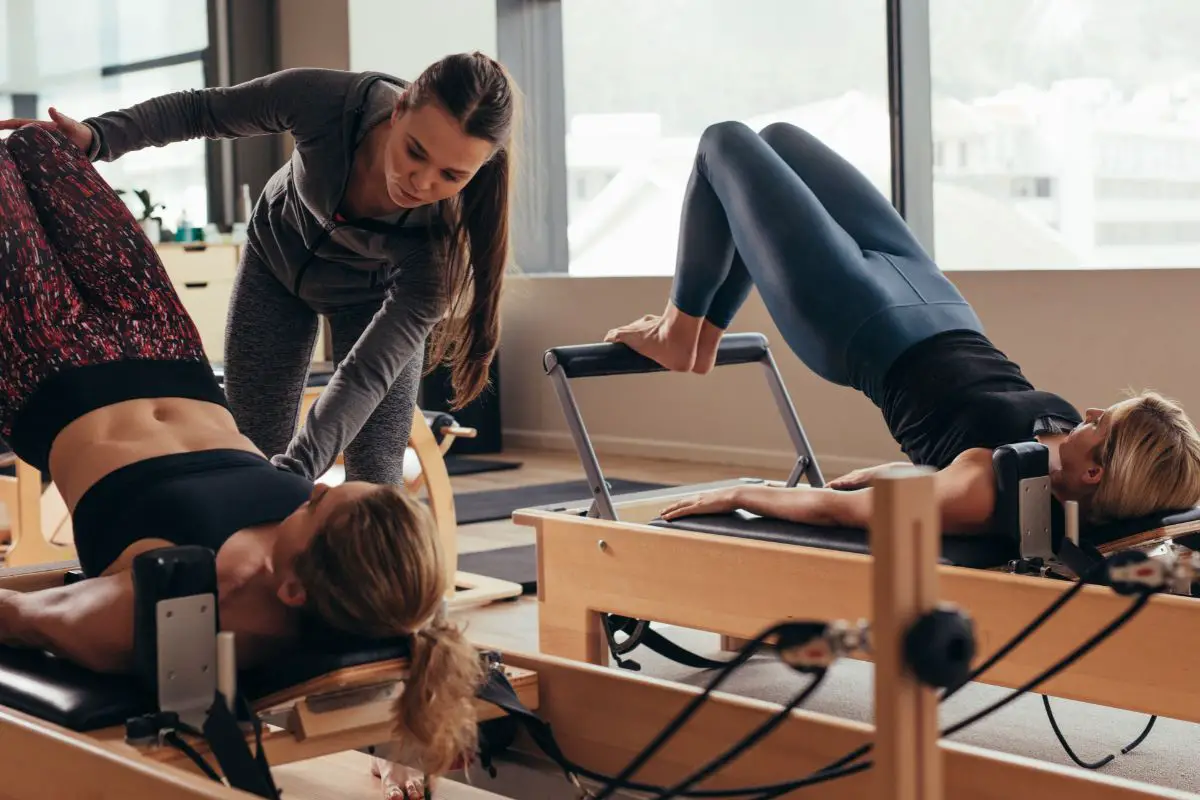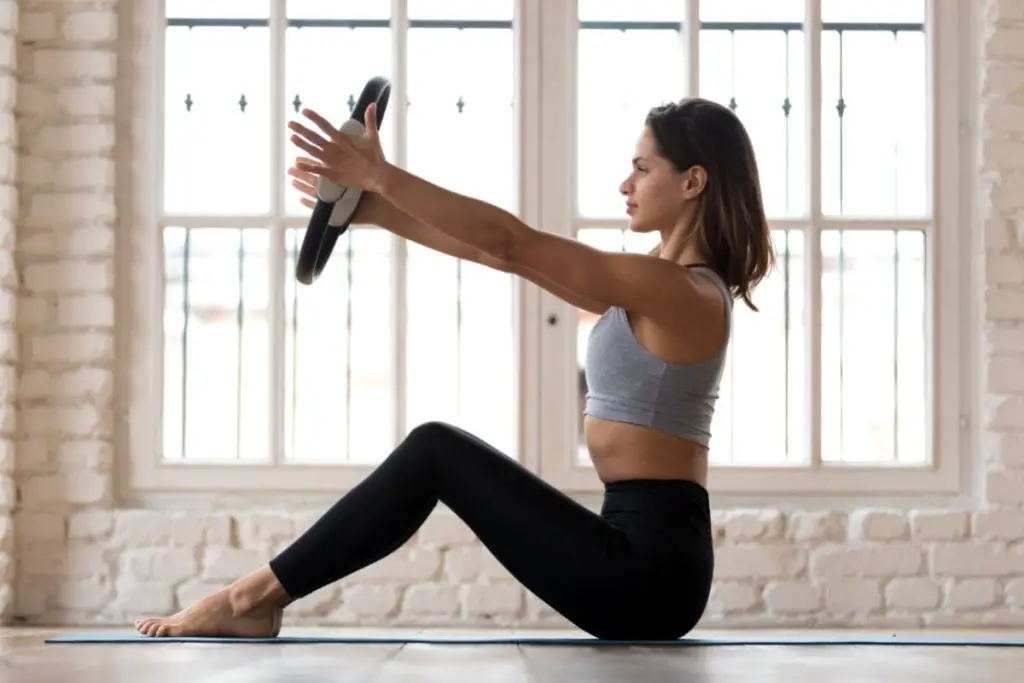Mat Vs. Reformer Pilates – Which Method Is Best For You?
You might be a Pilates newbie, but the practice is several years old.
It’s named after the German physical trainer, Joseph Pilates, who designed the exercise system to help his peers within World War One detention camps.
To this day, the movements are carried out in the way Pilates originally designed them, but there have been lots of updated styles that deviate from these traditional movements.
Beginners may find Pilates puzzling at first.
You may be familiar with ‘mat’ style Pilates, but you might have also seen people using a formidable-looking machine, known as a reformer.
Pilates can involve other pieces of equipment, like the Cadillac or the Tower, but reformer and mat Pilates are the most popular methods taught in Pilates studios.
Mat and reformer Pilates both have different benefits, but is there a winner between the two, and which one is best for you?
What Does Pilates Involve?
Pilates is an arrangement of movements that work well at building muscle tone and increasing strength.
They improve mobility and balance, helping the body feel better overall.
While many of the exercises used in Pilates affect all of the main muscles, they focus on targeting the ‘powerhouse’, which is your core.
The core includes the deeper and surface abdominal muscles, as well as the hips and lower back.
The core links and balances the lower and upper body, helping the two components work effectively together.
Mat Pilates uses body-weight exercises, like the single-leg circle, roll-up, and the Hundred.
These are carried out low to the floor, using flowing, even movements that don’t exert much pressure on the joints.
This makes mat Pilates suitable for a large range of people of different ages and health statuses.
Reformer exercises are carried out on a machine that delivers resistance through straps, springs, ropes, and gears.
Lots of the exercises on the reformer are like ones performed on the mat, except they are executed against extra resistance from the machine.
A significant component of Pilates is the special breathing technique, used in both reformer and mat exercises.
This involves inhaling so the rib cage expands outwards in all directions, then exhaling so the rib cage compresses again, lightly drawing the pelvic floor upwards in the process.
Breathing in and out is connected with each action to avoid holding your breath.
This breathing technique helps you connect to the mind-body essence of Pilates.
Different Styles Of Pilates
The other thing you’ll need to understand about Pilates is the difference between traditional Pilates and the contemporary style.
Classical Pilates uses the exercises as Joseph Pilates initially designed, so the movements are carried out in his original order.
Contemporary Pilates draws on the original classical style, but the system has adapted to respond to biomechanics, physical therapy, and scientific research.
A lot of the movements are identical to the classical exercises, but some of these have been modified, alongside newer exercises added to the system.
Contemporary and classical Pilates can both use reformer and mat exercises, so your experience will vary depending on the class that you attend.
Classical Pilates is ideal for people who thrive on repetition and structure, but this may be daunting for beginners just starting alongside regulars who know all the movements by heart.
Contemporary Pilates usually involves newer movements that most of the participants may not have practiced before.
This may make it less intimidating for beginners as even the experienced regulars are learning new techniques.
Which Is Best For You, Mat Or Reformer Pilates?

Anything that you try for the first time will be hard, challenging, and maybe even a little uncomfortable.
Beginners may feel weird at first, but this isn’t a bad thing.
Understanding that everyone was once in your position may take some of the pressure off of you.
Mat Pilates has some advantages, as there are many online videos you can try at home before attending a class.
This isn’t usually possible with reformer Pilates, unless you own the expensive device.
While mat Pilates can be done easily without much equipment, neither form is considered better than the other, even for beginners.
Reformer equipment may look intimidating, which is why mat Pilates may seem less daunting.
It often uses movements you may have seen in home videos or previous aerobic classes.
Despite this, reformer classes with equipment can make beginners feel more supported in difficult positions, helping them align and find balance easily.
The only instance where one type of Pilates might be considered better than the other is if the participant has physical restrictions.
If this is the case, reformer Pilates may be better than the mat version.
The reformer equipment can steady and support people with impaired mobility.
This can help them perform the exercises efficiently and avoid injury in the process.
Pilates Fitness Goals
After you’ve mastered the basic exercises and have started to feel more confident in class, you can choose which style of Pilates can help you reach your fitness goals.
For example, if you have weight loss goals, you may want to burn calories and increase your strength.
In this case, the reformer might be better than mat Pilates. Instructors usually increase the intensity during reformer classes.
Reformers also have jump boards, allowing you to do cardio alongside plyometric exercises.
This helps increase your calorie burn, helping you get into an energy deficit.
The reformer is also good if you want to increase strength and build muscle. You won’t gain a lot of muscle mass by using a reformer.
However, working against the resistance will help you become stronger and build muscle, without the bulk.
Both Forms Of Pilates Are Best
Pilates involves balance and harmony, and reformer and mat exercises work well when both styles are practiced.
Practically all of the movements done on the reformer can be performed on the mat.
You might not be able to perform a V-sit on the reformer immediately, but performing the exercise on a mat can help you increase your ability to perform it on the reformer.
It’s best to practice both forms of Pilates, but your budget will also affect which style you do.
Reformer Pilates has its advantages, but if classes are a little out of your price range, you’ll still see many similar benefits with mat Pilates.
No matter which form of Pilates you do, you need to keep consistent, or you won’t see the benefits.
If you are just starting, beginners should aim to practice Pilates two times a week.
This will help you get familiar with the language, get into a good exercise habit, and become more confident using the equipment.
Once you’ve reached these beginner goals, increase the number of sessions to three a week.
Practice both reformer and mat Pilates every week, provided that your budget and schedule permit this.
Two sessions a week is enough to notice good results, but three times per week will make Pilates part of your lifestyle.
The Bottom Line
Reformer and mat Pilates are both incredible forms of exercise, but there’s no need to choose one over the other.
You’ll see a lot of benefits from practicing both forms, but if this isn’t possible, you’ll get lots of benefits from either style.
Whichever method you end up choosing, always make sure that the teacher you are learning from is certified.
An uncertified instructor won’t be able to ensure that you are performing the movements correctly, which increases the risk of injury.
Whether you are attending a class or learning from an online video, always check that your instructor has the experience, certifications, and references.





